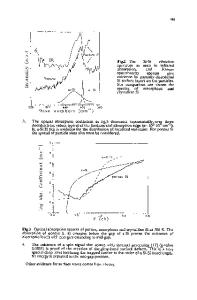The Luminescence Mechanism of Porous Silicon
- PDF / 472,777 Bytes
- 6 Pages / 420.48 x 639 pts Page_size
- 11 Downloads / 423 Views
THE LUMINESCENCE MECHANISM OF POROUS SILICON P.D.J. CALCOTT, K.J. NASH, L.T. CANHAM, M.J. KANE and D. BRUMHEAD Defence Research Agency (RSRE), St. Andrews Road, Malvern, Worcs. WR14 3PS, UK ABSTRACT We report resonantly excited photoluminescence (PL) spectroscopy of highly porous silicon. In the PL spectra we observe satellite structure due to the participation of momentum-conserving phonons in the optical transitions. The momentum-conserving role of these phonons, together with their energies and relative coupling strengths, demonstrate beyond doubt that crystalline silicon, which has already been shown to be the dominant constituent of unoxidised porous silicon, also forms the luminescent material. We show that the theory of quantum confinement in crystalline silicon wires can explain our results and those of other experiments, if the electron-hole interaction, and the localisation of carriers by fluctuations in wire width, are taken into account. I. INTRODUCTION Porous silicon has been the subject of many photoluminescence (PL) studies, since the 1 initial demonstration of efficient visible PL . The fact that none of these studies has observed unambiguous structure in the broad visible PL band of porous silicon has so far prevented clear identification of the luminescence mechanism. We have observed momentum-conserving phonon satellites of resonantly excited PL2. These results are employed in Secs. III-V to identify the PL mechanism of porous silicon. Sec. VI presents our theory of the electronic structure of porous silicon and shows how this theory can explain the results of photoconductivity and electroluminescence experiments. II. EXPERIMENTAL DETAILS The sample studied in this paper was prepared, two years before these experiments, by 2 anodisation of p-type silicon (resistivity 40f7cm) at 20mAcm- for 5min in 20% ethanoic HF. The porosity of the fresh layer was 80%. This sample is the same one that was studied in Ref. 2, in which it was called sample 'B'. PL was excited with argon, dye or Ti-sapphire laser light, and time-resolved measurements were performed with an acousto-optic modulator, photomultiplier and a gated photon counter. Spectral lineshapes were corrected by reference to a calibrated source. The sample was cooled to temperature T = 2K by immersion in superfluid helium. The non-resonantly excited PL spectrum is given in Ref. 2. We study the main PL band, called the 'S' band in Ref. 2, which comprises 97% of the PL intensity, and has a peak energy of 1.72eV and a full-width at half-maximum (FWHM) of 0.42eV. The experiments described in this paper deal with absorption and luminescence due to the localised exciton states which give rise to this PL 3 band , 2 III. OPTICAL PROPERTIES OF LOCALISED EXCITONS IN CRYSTALLINE SILICON We begin by discussing the optical properties that are expected for localised excitons in crystalline silicon, using as a guide the well-established properties of excitons localised at point defects in bulk crystalline silicon 4. The low-temperature PL of such excitons has been
Data Loading...
